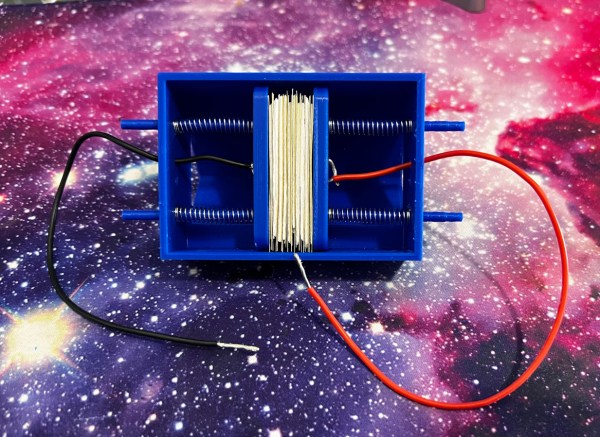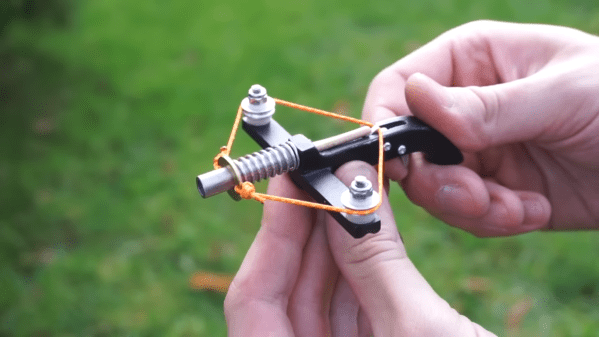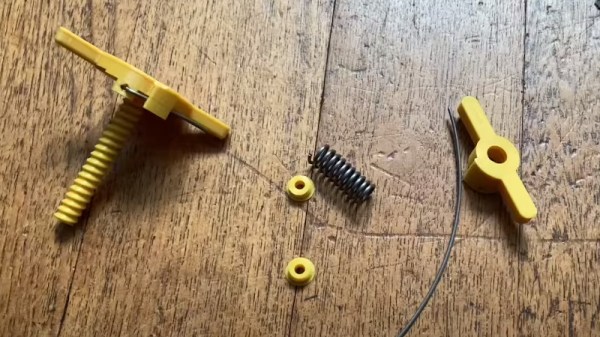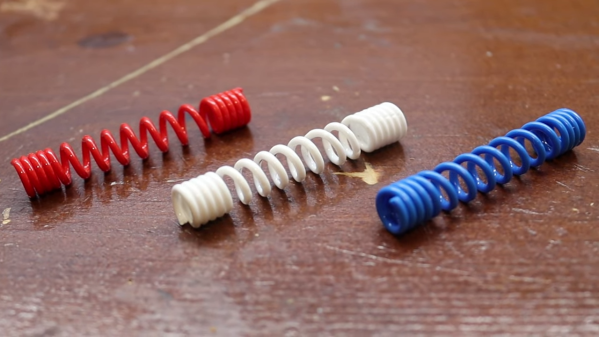In the technologically-underpinned modern world, most of us interact with a battery of some sort every day. Whether that’s the starter battery in a car, the lithium battery in a phone, or even just the coin cell battery in a wrist watch, batteries underpin a lot of what makes society possible now. Not so in the early 1800s when chemists and physicists were first building and experimenting with batteries. And those batteries were enormous, non-rechargable, and fairly fragile to boot. Not something suited for powering much of anything, but if you want to explore what it would have been like to use one of these devices, follow along with [Christopher]’s build of a voltaic pile. Continue reading “The Voltaic Pile: Building The First Battery”
spring33 Articles
Tiny Palm-Sized Crossbow Build Is Cute And Dangerous
Crossbows were a major development in the history of weaponry. They enabled lesser-skilled soldiers to shoot arrows at great speed in a compact form-factor. You can now build your own tiny version, thanks to this creation from [Maciej Nowak].
The main body of the crossbow was cut from a piece of aluminium bar stock, being shaped with an angle grinder. A slot was then machined to mount the crossbar and pulleys. A round piece of aluminium tube serves as a spring holder, and the spring is tensioned via pulling back a length of sailing rope to rest on a latch. The latch is released by a small trigger, just like on a full-size crossbow.
The arrows (or bolts, more typically) were made by machining skewers and giving them hard metal tips cut from nails. This enables them to penetrate apples, and presumably other fruits. They fly straight enough to reliably hit a target from a meter or two away.
We’ve seen other crossbow builds before, like this one that fires cannonballs! Just be careful where you aim, and don’t get yourself or anyone else hurt.
Continue reading “Tiny Palm-Sized Crossbow Build Is Cute And Dangerous”
Mouse Finds New Home In Pinball Machine
Restoring pinball machines is an excellent hobby, and can even be more than that as we see businesses like bars and museums focusing on them as a main attraction. There’s all kinds of intrigue to be found, from esoteric mechanical systems to classic electronics and unique artwork. For those building new pinball machines, though, one way to bypass a lot of the hassle of finding antiquated parts is to build a digital machine with an analog feel, like this machine which repurposes a computer mouse in an interesting way.
One of the important design considerations with a more modern system like this is to preserve the mechanical components that the player interacts with, in this case the plunger. This pinball machine is really just a large screen driven by a computer, but the plunger is a spring-loaded one from an old analog machine. Attached to the end of the plunger inside the cabinet is a cloth strap which passes underneath an old optical mouse. When the plunger is pulled and released, the mouse registers the position of the plunger and sends that information to the computer controlling the pinball display.
We really appreciate a KISS-style design like this in general. Mice are a proven, reliable technology and the metal components of the plunger are unlikely to ever wear out, which means that at least this part of the new pinball machine is unlikely to need much maintenance over the lifespan of the cabinet itself. For other ways of preserving the original feel of old machines, take a look at this build which incorporates all kinds of tricks within a MAME cabinet.
Simple Snap Action Mechanism Is 100% 3D Printed
Plastics are wonderous materials, much loved for their ability to elastically deform and spring back to their original shape. They’re a category of materials perfect for creating things like living hinges and similar mechanisms, and this 3D printed snap action device shows that off admirably.
The device consists of an outer housing, into which two printed springs are inserted. These leaf springs are curved and protrude towards the center of the housing. A slide is then inserted into the housing with a cam in its middle. The cam allows the slide to push past the springs when actuated, while also holding it in place at rest.
As demonstrated the mechanism reliably snaps back and forth between its two positions in a satisfying manner. It’s shown with one side of the housing removed so we get a good idea of how it works. It’s 100% 3D printed, as well. Anyone looking to replicate the design should note the importance of printing orientation, particularly in the case of the spring pieces, which won’t work if layered up in the wrong way.
Overall, it’s a neat design that could prove useful for those eager to build printed switches or other mechanical devices. It’s also simply a great way to learn about 3D printed springs and working with deformable plastic structures. Video after the break.
Continue reading “Simple Snap Action Mechanism Is 100% 3D Printed”
3D Printed Jig Makes Custom Springs A Snap
We’ve often heard it said that springs come in in all shapes and sizes…except for the one you need. In light of this, the hardware hacker would do well to keep the tools and knowledge required to make a custom spring close at hand when building something that moves. Luckily, all it really take is some stiff metal wire, a rod, and patience.
Unless you’ve got a 3D printer, that is. In which case, we’d suggest you print out this very clever “Spring Factory” designed by [Vincent Baillet]. The simple tool, consisting of just two parts, makes it easier and faster to make consistent DIY springs when compared to traditional methods. Rather than trying to eyeball the spacing of the coil as you wind the wire around the mandrel, this design does it for you.
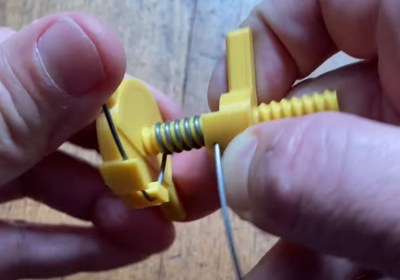 As seen in the video, springs made with this tool look very professional. Not only does the threaded mandrel keep the spacing between coils even, it also makes sure all the springs you produce are identical. This can be especially important with projects that need to use multiple matching springs. [Vincent] says his handy tool works with piano wire from 0.8 to 1.2 mm, and slightly thicker if plain steel.
As seen in the video, springs made with this tool look very professional. Not only does the threaded mandrel keep the spacing between coils even, it also makes sure all the springs you produce are identical. This can be especially important with projects that need to use multiple matching springs. [Vincent] says his handy tool works with piano wire from 0.8 to 1.2 mm, and slightly thicker if plain steel.
Of course, the obvious flaw in a tool like this is that it can only be used to make springs of a specific diameter. Changing the length is easy enough, just use more or less wire. But to make a thinner or thicker spring, you’d need a different size of mandrel. It seems that [Vincent] has only released the gadget in this approximately 9 mm diameter so far, but here’s hoping a few more sizes get added to the mix before too long.
Looking for something a bit more advanced? This Arduino-powered wire bender is capable of making some very impressive custom springs, among other things.
Continue reading “3D Printed Jig Makes Custom Springs A Snap”
Heat Turns 3D Printer Filament Into Springs
 The next time you find yourself in need of some large-ish plastic springs, maybe consider [PattysLab]’s method for making plastic springs out of spare filament. The basic process is simple: tightly wind some 3D printer filament around a steel rod, secure it and wrap it in kapton tape, then heat it up. After cooling, one is left with a reasonably functional spring, apparently with all the advantages of annealed plastic.
The next time you find yourself in need of some large-ish plastic springs, maybe consider [PattysLab]’s method for making plastic springs out of spare filament. The basic process is simple: tightly wind some 3D printer filament around a steel rod, secure it and wrap it in kapton tape, then heat it up. After cooling, one is left with a reasonably functional spring, apparently with all the advantages of annealed plastic.
The basic process may be simple, but [PattysLab] has a number of tips for getting best results. The first is to use a 3D-printed fixture to help anchor one end of filament to the steel rod, then use the help of an electric drill to wind the filament tightly. After wrapping the plastic with kapton tape (wrap counter to the direction of the spring winding, so that peeling the tape later doesn’t pull the spring apart), he suspends it in a pre-heated oven at 120 C for PLA and 160 C for PETG. How long does it stay in there? [PattysLab] uses the following method: when the spring is wound, he leaves a couple inches of filament sticking out to act as a visual indicator. When this segment of filament sags down, that’s his cue to begin the retrieval process. After cooling, the result is a compression or extension spring, depending on how it was wound before being heated.
[PattysLab] shared a short video on this Reddit post that shows both springs in action, and the process is all covered in the video, embedded below.
Continue reading “Heat Turns 3D Printer Filament Into Springs”
Springs And Things Wrap Into A Polyhedron Of Interactive LED Art
Any resemblance between The Wobble Sphere and a certain virus making the rounds these days is purely coincidental. Although as yet another project undertaken during the COVID-19 lockdowns, we can see where the inspiration came from.
Wobble Sphere is another work of interactive art from the apparently spring-driven imagination of [Robin Baumgarten], whose Quantum Garden piece graced our pages last year. The earlier, flatter version used a collection of spring door stops — the kind that sound awesome when plucked by a passing foot — each of which is surrounded by a Neopixel ring. The springs act as touch sensors that change the patterns and colors on the LED rings in endlessly fascinating ways.
For Wobble Sphere, [Robin] took the same spring and LED units, broke them into a collection of hexagonal and pentagonal PCBs, and wrapped the whole thing up into a 72-sided polyhedron. There’s some impressive mechanical and electrical engineering involved in the transition from 2D to 3D space, not least of which is solving the problem of how to connect everything while providing pluck-friendly structural support. The former was accomplished with a ton of ribbon cables, while the latter was taken care of with a combination of a 3D-printed skeleton and solder connections between adjacent PCBs. The result is a display that invites touch and rewards it with beautiful patterns of light chasing around the sphere. See it in action in the video after the break.
Lest anyone think springs are the only tool in [Robin]’s box, we mustn’t forget that he once set a knife-wielding Arduino-powered game on an unsuspecting public. Check it out; it’s way more fun than it sounds.
Continue reading “Springs And Things Wrap Into A Polyhedron Of Interactive LED Art”

